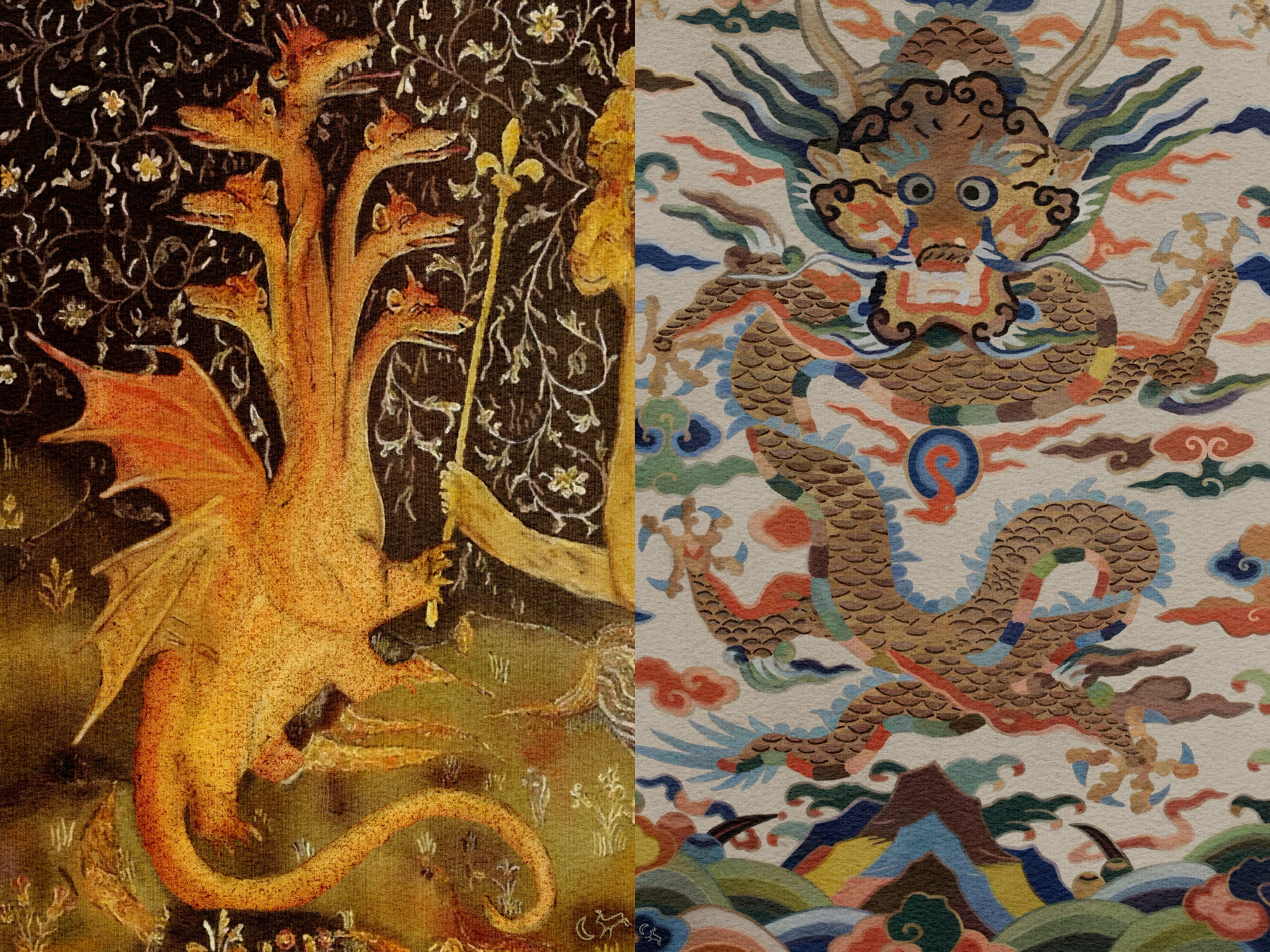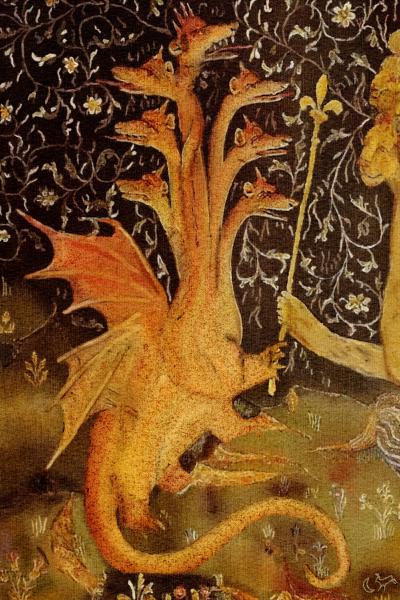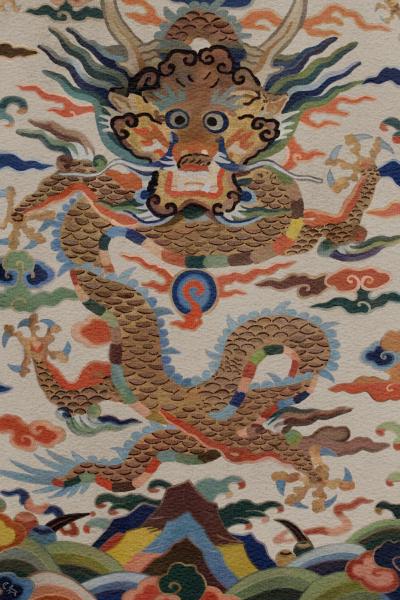
The state of the tapestry section with the story extraction roughly in place for both tapestries…
Some Woven Dragons
My mind gleans meaning via metaphorical odyssey. This particular expedition's point of origin practically presents itself. Threads are but thin yarns, after all, and what are myths if not stories? Let us explore the storyteller and the threads of thought with which his yarn is spun.
Consider this, a picture tells a thousand stories while it also tells its own. Narratives are recursive constructs. A story is a narrative. A picture represented as a digital image encodes these narratives within its pixels. A picture represented as a tapestry encodes these narratives within its threads. Narratives transmit beliefs. Beliefs compose a worldview. So, then, must a tapestry.
The storyteller spins a yarn for transmitting select information as a recognizable pattern from which meaning may be gleaned. The raconteur, with his hanks of yarn, is a weaver—carefully crossing threads until a tapestry takes shape that tells a thousand stories. There are many such tapestries to be found in our histories whose shape is that of a dragon. I've painted two of them for us to examine and see what we find in their threads.
Some Apocalyptic Threads
First, we'll look at the recursive story composition woven into a portion of the twelfth panel of the third Apocalypse Tapestry, conceptualized by Flemish painter Hennequin of Bruges and constructed inside the Parisian workshops of Nicholas Bataille.

I suppose we should briefly go over what I mean by recursion before I continue. That this first example is actually a portion of a fourteen panel tapestry kinda plays into the whole recursive composition concept. Clearly, each panel tells a story. The tapestry in its entirety also tells a story. It's a story within which each panel's story happens to be embedded. A story made of stories. This, for those of y'all without a background in mathematics or computer science, is recursion in a nutshell.
Within each panel, the weaver tells a story, perhaps more than one. It's important to understand that the recursion does not necessarily, in fact, it's unlikely to, end with these stories. Short of the telling of a story fabricated entirely within the mind of a weaver that had managed to master textiles whilst whiling away on the deserted island upon which they'd washed up as a baby to be raised by some language-less species, the story told by the weaver incorporates stories that predate the tapestry's creation. If you aren't quite sure what I mean, I think you will be once we've dug in a bit. Time for some story extraction.
We needn't know the tapestry's origin, medieval France, to surmise that what stands before us (with a weird little buddy) is a western dragon. If you look past the head and wing count, he kinda looks like the dragon from that medieval manuscript. Had I shown you all eight of the panels from this tapestry in which our fella makes an appearance, many of the Indo-European dragon motifs would catch your eye, most notably the dragon's mastery over water, his harassment of a maiden (whose baby he wants to devour), and a bout with spear hero. How many stories, by the year 1375, must lay in the lineage of the western dragon?
Here's where it gets interesting, we've barely scratched the surface–for the majority of this tapestry was woven with yarn spun by John while in exile on the Greek island of Patmos. He was all:
12:3 καὶ ὤφθη ἄλλο σημεῖον ἐν τῷ οὐρανῷ, καὶ ἰδοὺ δράκων πυρρὸς μέγας, ἔχων κεφαλὰς ἑπτὰ καὶ κέρατα δέκα καὶ ἐπὶ τὰς κεφαλὰς αὐτοῦ ἑπτὰ διαδήματα,
12:4 καὶ ἡ οὐρὰ αὐτοῦ σύρει τὸ τρίτον τῶν ἀστέρων τοῦ οὐρανοῦ καὶ ἔβαλεν αὐτοὺς εἰς τὴν γῆν. καὶ ὁ δράκων ἕστηκεν ἐνώπιον τῆς γυναικὸς τῆς μελλούσης τεκεῖν, ἵνα ὅταν τέκῃ τὸ τέκνον αὐτῆς καταφάγῃ.
You may (or may not) be familiar with John's story. Were he translated into English, he'd be all:
12:3 And another sign was seen in heaven, and behold, a great red dragon, having seven heads and ten horns, and on his heads seven crowns,
12:4 and his tail is pulling one third of the stars from heaven; and it threw them to the earth. And the dragon took his stand in front of the woman who was about to deliver, so that he might devour the child whenever it was born.
So, yeah, this isn't just any old dragon. This is that apocalypse. Those were passages from ΑΠΟΚΑΛΥΨΙΣ ΙΩΑΝΝΟΥ (pronounced The Revelation of John (and that's a wrap on pronunciation jokes)). This is f$&kin' Satan, as John lets us know a few passages later:
12:9 καὶ ἐβλήθη ὁ δράκων ὁ μέγας, ὁ ὄφις ὁ ἀρχαῖος, ὁ καλούμενος Διάβολος καὶ ὁ Σατανᾶς, ὁ πλανῶν τὴν οἰκουμένην ὅλην – ἐβλήθη εἰς τὴν γῆν, καὶ οἱ ἄγγελοι αὐτοῦ μετ’ αὐτοῦ ἐβλήθησαν.
Translated here into another run-on sentence (see … my writing style ain't faux-pas-matic … it's f$&kin' biblical):
12:9 And the great dragon was thrown out, that ancient serpent, which is called the Devil and Satan, who deceives the whole world, he was thrown to the earth, and his angels thrown along with him.
The fella on the right is some bearionard John just calls beast. Our dragon, here, happens to be passing along his power (which I guess he keeps in a scepter ¯\_(ツ)_/¯). I better just let John explain:
13:2 καὶ τὸ θηρίον ὃ εἶδον ἦν ὅμοιον παρδάλει, καὶ οἱ πόδες αὐτοῦ ὡς ἄρκου, καὶ τὸ στόμα αὐτοῦ ὡς στόμα λέοντος. καὶ ἔδωκεν αὐτῷ ὁ δράκων τὴν δύναμιν αὐτοῦ καὶ τὸν θρόνον αὐτοῦ καὶ ἐξουσίαν μεγάλην.
Which not a one of you are gonna f$&kin' understand, so here's a guy explaining what John explained:
13:2 And the beast which I saw was like a leopard, and the feet of it like a bear's, and his mouth like the mouth of a lion. And the dragon gave his power to him, and his throne, and great authority.
Having sufficiently covered the whole stories-made-of-stories angle and drawn out the more interesting bits of this particular great red dragon's story (browbeating y'all with ancient Greek I sure as shit can't read along the way). Let's move on to the kesi (silk tapestry) I painted.
Some Benevolent Threads
Woven two hundred years later, give or take, on another continent entirely, this happy little fella likely hung about upon an altar as part of a ceremonial arrangement.

The museum that restored this particular tapestry says it was originally part of a larger hanging. I am entirely ignorant as to the contents of the accompanying panels. Seeing as I've already made my point about recursive composition, I think we're fine with what we've got.
Just as western dragons carry their Indo-European roots, Chinese dragons carry their Sino-Tibetan roots. This little cutie likely landed his gig on account of his standup delivery of prosperity, good luck, and rainfall to those in his care.
"How does he make it rain?"
Glad you asked. You see Zhuang Zhou 莊周 clued us in circa the third century BCE in The Revolution of Heaven 天運 chapter from the Outer Chapters 外篇 of his book, Zhuangzi 莊子 (the book would go on to become kind of a big deal):
龍合而成體,散而成章,乘乎雲氣而養乎陰陽。
Which, per translation by James Legge, amounts to:
The dragon coils itself up, and there is its body; it unfolds itself and becomes the dragon complete. It rides on the cloudy air, and is nourished by the Yin and Yang.
So, what we appear to have is a dragon flying about munching up Yin and Yang.
"The f$&k that have to do with rain?"
We may ascertain the f$&k it doth from Guo Pu 郭璞, who documented the whole process in the Flow of Qi section from the Inner Chapters of the Zangshu 葬書, a book he wrote some time in the late third or early fourth century CE (the first book known to mention feng shui, it also would become kind of a big deal):
隂陽之氣即地中之生氣故噫為風升為雲降為雨凡所以位天地育萬物者何莫非此氣邪斯蓋因曰葬乗生氣故重舉以申明其義愚嘗謂能生能殺皆此氣也葬得其法則為生氣失其道則為殺氣如所謂加減饒借吞吐浮沉之類並當依法而剪裁之不致有撞殺沖刑破腮翻鬬之患也
Which amounts to the following, if you're asking Stephen Field:
The qi of yin and yang breathes out as wind, rises up as clouds, descends as rain, and courses underground as vital energy.
You'll recall that we have a dragon flying about, munching up Yin and Yang. The exhalant air in the dragon seeds the skies with qi extract obtained from such a meal. In other words, he makes clouds with his breath (one assumes, dear reader, that you can make the leap from clouds to rain on your own).
Notice the flaming pearl there in the center. Were the dragon not flying about sucking qi out of Yin and Yang, that little orb is likely chock-full of qi. The bestowable gifts he might conjure out of its contents are countless. Useful fellow to have in your corner either way.
Now that we know what he's doing there, what might we uncover as to how he looks doing it? Here it helps to know the birthdate for our benevolent buddy. This particular kesi was created in the tail end of the Ming dynasty, which places his birth near the end of the sixteenth century or the beginning of the seventeenth century. It also places him near the tail end of the Chinese dragon's evolutionary timeline, so he's chock-full of the symbology he's inherited.
His cloud dragon heritage dates back to the Neolithic period, which ended around 1700 BCE. The flying dragon (Feilong 飛龍; fēilóng) began popping up in classic texts some time before the fourth century BCE. Don't believe me? Check the Qian ䷀乾 hexagram of the Yi Jing 易經:
九五:飛龍在天,利見大人。
If Richard Wilhelm is to be believed, this translates into English as:
Nine in the fifth place means: Flying dragons in the heavens.
Check those fully five-toed feet of his. We know from our previous discussion that having five toes is totally a thing. The rest of the dragon's body parts also seem to follow precedent. Everyone seems to want to credit Wang Fu for its documentation. The nearest I could get to the original (which may have been lost) was through the entry for dragon 龍 found in the 43rd volume, One of Scales 鳞之一, of Compendium of Materia Medica 本草綱目–an encyclopedia first published in 1578 (the most complete and comprehensive book written in the history of traditional Chinese medicine, it would join the others I've mentioned as kind of a big deal):
時珍曰︰按︰許慎《說文》︰龍字篆文象形。《生肖論》云︰龍耳虧聰,故謂之龍。《生肖論》云︰龍耳虧聰,故謂之龍。《梵書》名那伽。時珍曰︰按︰羅願《爾雅翼》云︰龍者鱗蟲之長。王符言其形有九似︰頭似駝,角似鹿,眼似兔,耳似牛,項似蛇,腹似蜃,鱗似鯉,爪似鷹,掌似虎,是也。其背有八十一鱗,具九九陽數。其聲如戛銅盤。口旁有須髯,頷下有明珠,喉下有逆鱗。頭上有博山,又名尺木,龍無尺木不能升天。呵氣成雲,既能變水,又能變火。陸佃《埤雅》云︰龍火得濕則焰,得水則燔,以人火逐之即息。王符言其形有九似︰頭似駝,角似鹿,眼似兔,耳似牛,項似蛇,腹似蜃,鱗似鯉,爪似鷹,掌似虎,是也。
It turns out that tracking down the consensus for what this translates to in English is some bullsh$t. My favorite comes from the book Mythical Monsters, by Charles Gould (whose translation earns points for being question mark inclusive). Stick a pin in what Wang Fu says and that wooden foot-rule; otherwise, we're golden:
According to the dictionary of Hü Shăn, the character lung in the antique form of writing represents the shape of the animal. According to the Shang Siao Lun, the dragon is deaf, hence its name of lung (deaf). In Western books the dragon is called nake (naga). Shi-Chăn says that in the ’Rh Ya Yih of Lo-Yuen the dragon is described as the largest of scaled animals (literally, insects). Wang Fu says that the dragon has nine (characteristics) resemblances. Its head is like a camel's, its horns like a deer's, its eyes like a hare's, its ears like a bull's, its neck like a snake's, its belly like an iguanodon's (?), its scales like a carp's, its claws like an eagle's, and its paws like a tiger's. Its scales number eighty-one, being nine by nine, the extreme (odd or) lucky number. Its voice resembles the beating of a gong. On each side of its mouth are whiskers, under its chin is a bright pearl, under its throat the scales are reversed, on the top of its head is the poh shan, which others call the wooden foot-rule. A dragon without a foot-rule cannot ascend the skies. When its breath escapes it forms clouds, sometimes changing into rain, at other times into fire. Luh Tien in the P’i Ya remarks, when dragon-breath meets with damp it becomes bright, when it gets wet it goes on fire.
It's the near sentence for sentence translation correlation and his marking of what he wasn't sure was correct that I appreciate. We can combine this translation with the two things James Legge grokked that Gould missed (it's worth noting that a footnote in Gould's book totally makes Legge look foolish for mistaking hare for demon and totally harshing the whole nine-animal vibe of a benevolent being). Legge's translation specifies the belly as that of a clam(-monster) or shen 蜃. As the belly referenced is meant to be internal (don't think so? You show me where the belly is then), what it is meant to resemble doesn't much matter short of need arising for the proper disection of a dragon. Legge's other contribution is the substitution of the poh shan or wooden foot-rule with a thing like a broad eminence (a big lump), called ch'ih muh (尺木).
Let's evaluate how much of Wang Fu's story we see coiled before us. I can't in good conscience try telling y'all that any of those feet have tiger paws. I already dismissed the belly as unknowable. May as well add the eyes, and the throat scale direction to that list. I'm calling the other seven similarities present, as are the whiskers and the ch'ih muh. Whether the pearl is there appears to be a toss up, depending on whether that green thing could be a pearl and whether that flaming pearl would also count. Those happen to be backfins running the length of him, for what it's worth–and those flamboyant little arm and leg dangles, well, it's quite possible that these flame and cloud patterns are vestigial wings tracing back to the yellow dragons of the Shang and Zhou dynasties.